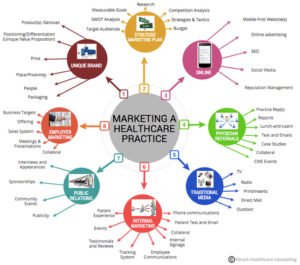Introduction:
Email Is Still King—Even in Healthcare
In an era where social media dominates, it’s easy to overlook the power of email. Yet, in healthcare, where trust, privacy, and personalized communication are non-negotiable, email remains one of the most effective and underutilized tools.
Why? Because when used right, email doesn’t just deliver messages—it builds relationships.
Unlike the retail or entertainment industries, email marketing strategies for healthcare must be designed with compassion, compliance, and credibility in mind. You’re not promoting a discount on a smartwatch. You’re guiding someone through a health journey.
This article uncovers real, proven, and ethical email marketing strategies for healthcare that feel personal, add value, and build long-term trust with patients and clients.

Why Email Marketing Is Crucial in Healthcare
1. Direct Access to Patient Inbox
Unlike social media where algorithms play gatekeeper, email lands directly in the patient’s inbox. That’s direct access, no middleman.
2. Builds Long-Term Patient Relationships
Patients want a consistent source of information from trusted providers. Well-crafted emails foster ongoing relationships and reduce churn.
3. HIPAA-Compliant Communication Is Possible
With the right tools and encryption, email marketing strategies for healthcare can be compliant, private, and secure—unlike many other platforms.
Key Email Marketing Strategies for Healthcare
1. Segment, Segment, Segment
Let’s face it: Not all your subscribers are alike.
a. Demographics-Based Segmentation
Age, gender, and location can heavily influence the content someone finds relevant. A 24-year-old athlete and a 68-year-old retiree have different healthcare needs.
b. Behavioral Segmentation
Track open rates, past appointment history, or the services they inquired about. Then tailor your emails accordingly.
2. Send Personalized Health Tips
A generic email that says, “Stay healthy!” won’t cut it.
Use the power of personalization to suggest:
-
Healthy recipes for diabetic patients
-
Exercises for arthritis relief
-
Post-operative care reminders
These types of content don’t feel like marketing—they feel like support.
3. Automated Appointment Reminders
One of the most practical email marketing strategies for healthcare is automating appointment confirmations, follow-ups, and reminders. Patients actually appreciate them.
This not only reduces no-shows but also shows patients that you respect their time.
4. Provide Educational Content Regularly
Be more than a provider—be a guide.
Send monthly newsletters that include:
-
Recent medical findings
-
Common seasonal health advice
-
Prevention techniques
-
FAQ on popular treatments
This keeps your audience engaged and positions you as a credible source of information.
5. Encourage Preventive Care
Use data to identify patients who might benefit from screenings or wellness visits and send targeted emails like:
“Hi Anjali, it’s been over a year since your last pap smear. Prevention is key—schedule your screening today.”
Emails like this aren’t salesy—they’re helpful.
6. Include Strong CTAs (Calls to Action)
Each email should lead to a next step, whether it’s:
-
Scheduling a check-up
-
Downloading a guide
-
Calling a nurse helpline
Don’t let your email end in dead air. A CTA is the bridge between information and action.
Mistakes to Avoid in Healthcare Email Marketing
Being Too Sales-Oriented
Healthcare is about care—not pushing products. Always aim to inform, not sell.
Ignoring Mobile Optimization
Over 70% of users read emails on their phones. If your email isn’t mobile-friendly, you’re losing your audience.
Not Respecting Privacy
Never send personal health information (PHI) unless the platform is secure and HIPAA-compliant.
Email Types That Work Best in Healthcare
Welcome Emails
Warm and informative. Tell patients what kind of emails to expect.
Newsletter
Include helpful articles, tips, and announcements.
Reminders
Preventive checkups, flu shot season, annual screenings.
Follow-Up Emails
Post-appointment care instructions or health surveys.
Re-engagement Emails
For patients who haven’t visited in a while—send gentle reminders and updates.
Metrics That Matter
You can’t improve what you don’t measure. Track:
-
Open Rate – Are people interested in your subject lines?
-
Click-Through Rate (CTR) – Are your CTAs effective?
-
Unsubscribe Rate – Are you emailing too often or off-topic?
-
Conversion Rate – Are users taking the action you want?
These indicators help you refine your email marketing strategies for healthcare continuously.
Myths vs. Facts: Email Marketing in Healthcare
| Myth | Fact |
|---|---|
| Email marketing is too informal for healthcare | Not true. If crafted well, it can be both professional and personal. |
| Patients don’t read emails | Emails about personal health have some of the highest open rates in the industry. |
| It’s impossible to be HIPAA-compliant via email | With secure platforms, yes you can. Just be mindful of PHI. |
| Email marketing is outdated | It still has one of the best ROIs compared to any marketing channel. |
Frequently Asked Questions (FAQ)
Q1: Is email marketing even effective in the healthcare industry?
Absolutely. It’s one of the most cost-effective and personalized ways to communicate directly with patients.
Q2: How often should a healthcare practice send emails?
Once or twice a month is ideal for educational content. For appointment reminders or follow-ups, as needed.
Q3: Can email marketing be HIPAA-compliant?
Yes, if you use encrypted services and avoid sending personal health information unless absolutely necessary.
Q4: What should I include in a healthcare newsletter?
Tips, articles, upcoming events, patient stories, FAQs, and preventive care reminders.
Q5: How do I grow my email list ethically?
Use sign-up forms on your website, at reception desks, and after appointments. Always get explicit consent.
Pro Tips: Add a Human Touch
Here’s what separates robotic emails from real ones:
-
Use first names
-
Avoid jargon
-
Write like you speak
-
Include an actual doctor’s or nurse’s signature line
-
Share a real success story (with permission)
Emails shouldn’t feel like blasts. They should feel like conversations.

Conclusion: Time to Reimagine Healthcare Emails
You don’t need to flood inboxes. You just need to add value with every message.
Email marketing strategies for healthcare work best when they’re:
-
Personalized
-
Informative
-
Secure
-
Action-driven
If you’ve been ignoring email as a growth and trust-building channel, now’s the time to start fresh.
Whether you’re a clinic, private practice, or a healthcare consultant—start building your email marketing blueprint today. Begin with one email, one audience, and one goal. Then scale from there.
Your patients are checking their inbox. Are you showing up the right way?
